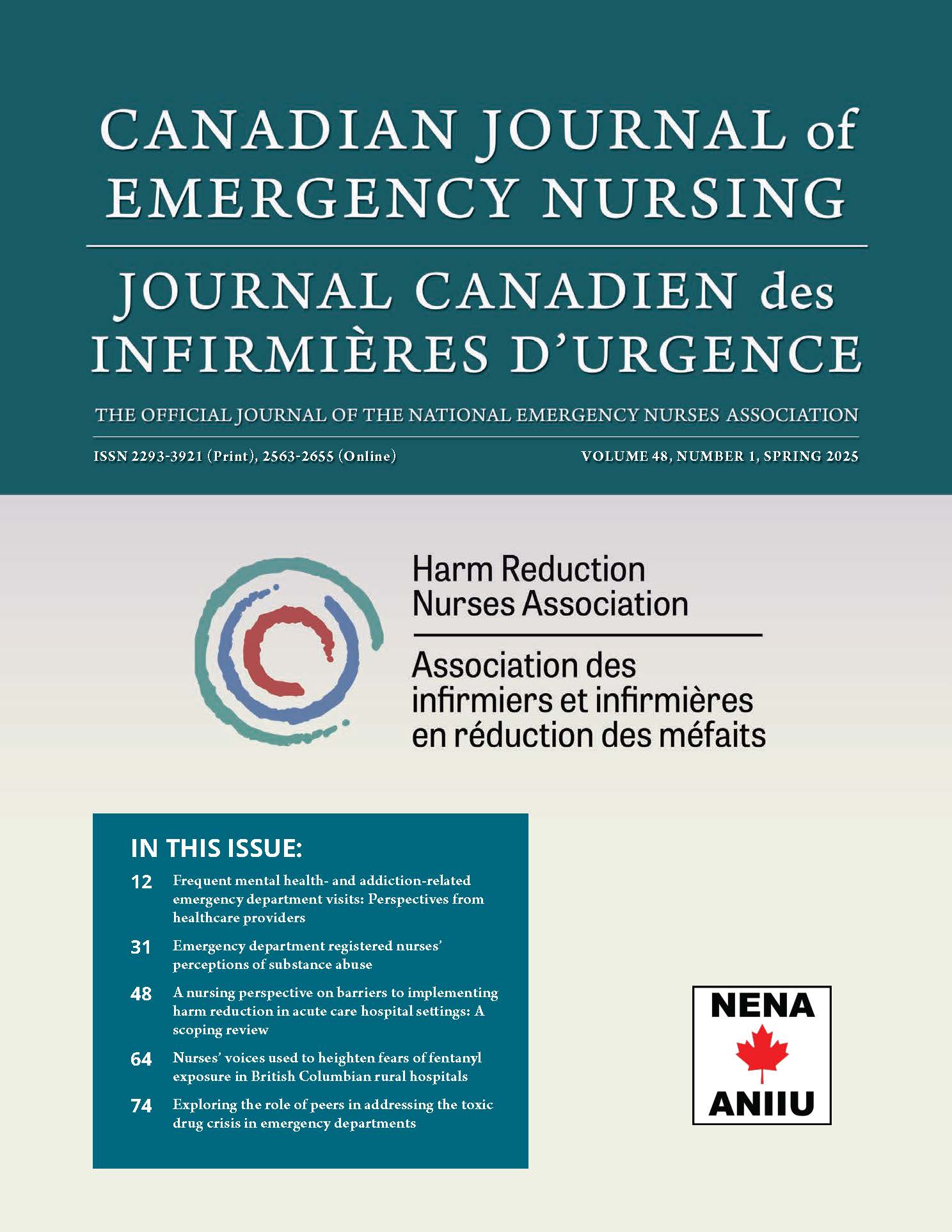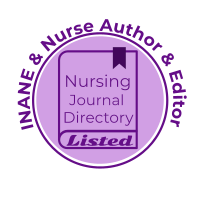Nurses’ voices used to heighten fears of fentanyl exposure in British Columbian rural hospitals
DOI:
https://doi.org/10.29173/cjen247Keywords:
occupational exposure, nursing profession, substance use conditions, drug policyAbstract
People who use drugs (PWUD) experience stigma when accessing hospital-based health care, including emergency care. Rural settings are of particular concern due to heightened social-structural stigma towards PWUD in smaller communities. These barriers have been further exacerbated by recent media attention where nurses’ voices have been used to influence political discourses regarding workplace exposure to second-hand smoke from unregulated substances (e.g. fentanyl and methamphetamine). Immediate collective nursing action is required to protect nurses’ professional and ethical obligations and ensure safe access to hospital care for PWUD in the current political climate in British Columbia, Canada.
References
Bardwell, G., Mansoor, M., Van Zwietering, A., Cleveland, E., Snell, D., & Kerr, T. (2022). The “goldfish bowl”: A qualitative study of the effects of heightened surveillance on people who use drugs in a rural and coastal Canadian setting. Harm Reduction Journal, 19(1), 136. https://doi.org/10.1186/s12954-022-00725-2
Barry, C. L., McGinty, E. E., Pescosolido, B. A., & Goldman, H. H. (2014). Stigma, Discrimination, Treatment Effectiveness, and Policy: Public Views About Drug Addiction and Mental Illness. Psychiatric Services, 65(10), 1269–1272. https://doi.org/10.1176/appi.ps.201400140
BC Nurses Union. (2024, May 7). Controlling Exposure Risks from Illicit Substances. https://www.bcnu.org/a-safe-workplace/health-and-safety/controlling-exposure-risks
Bourque, S., Pijl, E. M., Mason, E., Manning, J., & Motz, T. (2019). Supervised inhalation is an important part of supervised consumption services. Canadian Journal of Public Health, 110(2), 210–215. https://doi.org/10.17269/s41997-019-00180-w
Burgess, A., Bauer, E., Gallagher, S., Karstens, B., Lavoie, L., Ahrens, K., & O’Connor, A. (2021). Experiences of stigma among individuals in recovery from opioid use disorder in a rural setting: A qualitative analysis. Journal of Substance Abuse Treatment, 130, 108488. https://doi.org/10.1016/j.jsat.2021.108488
Chan Carusone, S., Guta, A., Robinson, S., Tan, D. H., Cooper, C., O’Leary, B., de Prinse, K., Cobb, G., Upshur, R., & Strike, C. (2019). “Maybe if I stop the drugs, then maybe they’d care?”—Hospital care experiences of people who use drugs. Harm Reduction Journal, 16(1), 16. https://doi.org/10.1186/s12954-019-0285-7
DeBeck, K., Cheng, T., Montaner, J. S., Beyrer, C., Elliott, R., Sherman, S., Wood, E., & Baral, S. (2017). HIV and the criminalisation of drug use among people who inject drugs: A systematic review. The Lancet HIV, 4(8), e357–e374. https://doi.org/10.1016/S2352-3018(17)30073-5
DeRosa, K. (2024, April 5). Nurses speak out about consequences of drug use in hospitals. https://vancouversun.com/news/nurses-speak-out-about-consequences-of-drug-use-in-hospitals
Dogherty, E., Patterson, C., Gagnon, M., Harrison, S., Chase, J., Boerstler, J., Gibson, J., Gill, S., Nolan, S., & Ryan, A. (2022). Implementation of a nurse-led overdose prevention site in a hospital setting: Lessons learned from St. Paul’s Hospital, Vancouver, Canada. Harm Reduction Journal, 19(1), 13. https://doi.org/10.1186/s12954-022-00596-7
Eagland, S., Ranger, C. & Wilson, P. (2024, May 23). Fears of exposure to illicit drugs in public places based on politics, not facts. https://healthydebate.ca/2024/05/topic/exposure-illicit-drugs-politics/
Ellis, K., Walters, S., Friedman, S. R., Ouellet, L. J., Ezell, J., Rosentel, K., & Pho, M. T. (2020). Breaching trust: Qualitative study of healthcare experiences of people who use drugs in a rural setting. Frontiers in Sociology, 5, 593925. https://doi.org/10.3389/fsoc.2020.593925
Fisher, J. (2007). Mental health nurses: De facto police. International Journal of Mental Health Nursing, 16(4), pp. 230-235. https://doi.org/10.1111/j.1447-0349.2007.00472.x
Fleming, P. & Sinnot, M-L. (2018). Rural physician supply and retention: Factors in the Canadian context. Canadian Journal of Rural Medicine, 23(1). https://www.srpc.ca/resources/Documents/CJRM/vol23n1/pg15.pdf
Hatzenbuehler, M. L., Phelan, J. C., & Link, B. G. (2013). Stigma as a fundamental cause of population health inequalities. American Journal of Public Health, 103(5), 813–821. https://doi.org/10.2105/AJPH.2012.301069
Henderson, S. (2002). Factors impacting on nurses’ transference of theoretical knowledge of holistic care into clinical practice. Nurse Education in Practice, 2(4), 244–250. https://doi.org/10.1016/S1471-5953(02)00020-3
Hu, K., Klinkenberg, B., Gan, W. Q., & Slaunwhite, A. K. (2022). Spatial-temporal trends in the risk of illicit drug toxicity death in British Columbia. BMC Public Health, 22(1), 2121. https://doi.org/10.1186/s12889-022-14586-8
Kennedy-Hendricks, A., Barry, C. L., Gollust, S. E., Ensminger, M. E., Chisolm, M. S., & McGinty, E. E. (2017). Social stigma toward persons with prescription opioid use disorder: Associations with public support for punitive and public health–oriented policies. Psychiatric Services, 68(5), 462–469. https://doi.org/10.1176/appi.ps.201600056
McEachern, J., Ahamad, K., Nolan, S., Mead, A., Wood, E., & Klimas, J. (2016). A Needs Assessment of the Number of Comprehensive Addiction Care Physicians Required in a Canadian Setting. Journal of Addiction Medicine, 10(4), 255. https://doi.org/10.1097/ADM.0000000000000230
Moss, M. J., Warrick, B. J., Nelson, L. S., McKay, C. A., Dubé, P.-A., Gosselin, S., Palmer, R. B., & Stolbach, A. I. (2018). ACMT and AACT position statement: Preventing occupational fentanyl and fentanyl analog exposure to emergency responders. Clinical Toxicology, 56(4), 297–300. https://doi.org/10.1080/15563650.2017.1373782
Muncan, B., Walters, S. M., Ezell, J., & Ompad, D. C. (2020). “They look at us like junkies”: Influences of drug use stigma on the healthcare engagement of people who inject drugs in New York City. Harm Reduction Journal, 17(1), 53. https://doi.org/10.1186/s12954-020-00399-8
Neale, J., Tompkins, C., & Sheard, L. (2008). Barriers to accessing generic health and social care services: A qualitative study of injecting drug users. Health & Social Care in the Community, 16(2), 147–154. https://doi.org/10.1111/j.1365-2524.2007.00739.x
Palombi, L. C., St Hill, C. A., Lipsky, M. S., Swanoski, M. T., & Lutfiyya, M. N. (2018). A scoping review of opioid misuse in the rural United States. Annals of Epidemiology, 28(9), 641–652. https://doi.org/10.1016/j.annepidem.2018.05.008
Pauly, B. (Bernie), McCall, J., Browne, A. J., Parker, J., & Mollison, A. (2015). Toward Cultural Safety: Nurse and Patient Perceptions of Illicit Substance Use in a Hospitalized Setting. Advances in Nursing Science, 38(2), 121–135. https://doi.org/10.1097/ANS.0000000000000070
Shaw, R. (2024, April 4). ‘Nobody signed up.. to be exposed to fentanyl in the workplace’ says nurse. https://northernbeat.ca/opinion/nobody-signed-up-to-be-exposed-to-fentanyl-in-the-workplace-says-nurse/
Stangl, A. L., Earnshaw, V. A., Logie, C. H., van Brakel, W., C. Simbayi, L., Barré, I., & Dovidio, J. F. (2019). The Health Stigma and Discrimination Framework: A global, crosscutting framework to inform research, intervention development, and policy on health-related stigmas. BMC Medicine, 17(1), 31. https://doi.org/10.1186/s12916-019-1271-3
Sweetman, M. (2024, November 21). Patient overdose death at Nanaimo hospital ‘didn’t have to happen,’ doctor says. https://thediscourse.ca/nanaimo/patient-overdose-death-at-nanaimo-hospital-didnt-have-to-happen-doctor-says
Taylor, A. (2024, May 7). Campbell River hospital staff exposed to illicit drug smoke: Island Health. https://www.campbellrivermirror.com/local-news/campbell-river-hospital-staff-exposed-to-illicit-drug-smoke-island-health-7326961
Van Boekel, L. C., Brouwers, E. P. M., Van Weeghel, J., & Garretsen, H. F. L. (2013). Stigma among health professionals towards patients with substance use disorders and its consequences for healthcare delivery: Systematic review. Drug and Alcohol Dependence, 131(1–2), 23–35. https://doi.org/10.1016/j.drugalcdep.2013.02.018
Van Dyk, S. (2024, May 7). The federal government grants B.C.’s request to recriminalize hard drugs in public spaces. https://www.ctvnews.ca/politics/federal-government-grants-b-c-s-request-to-recriminalize-hard-drugs-in-public-spaces-1.6876913
Vancouver Coastal Health. (2023, January 1). Possession of controlled substances for personal use. https://www.vch.ca/en/decriminalization-controlled-substances-personal-use
Downloads
Published
How to Cite
Issue
Section
License
Copyright (c) 2025 Kate Hodgson, Amanda Lavigne, Geoff Bardwell

This work is licensed under a Creative Commons Attribution 4.0 International License.
The Canadian Journal of Emergency Nursing is published Open Access under a Creative Commons CC-BY 4.0 license. Authors retain full copyright.




